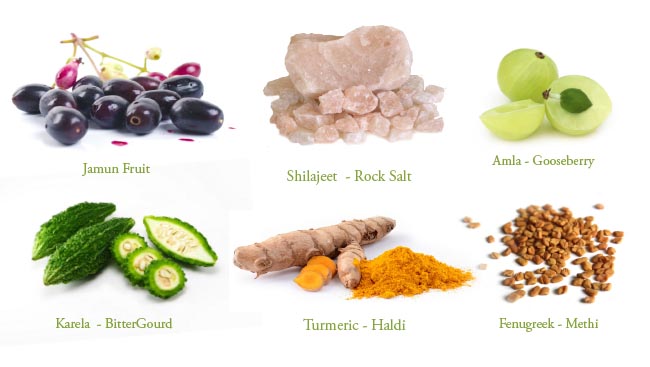Herbs for Diabetes
Herbs for Diabetes
There are many herbs which are very effective in curing diabetes and controlling associated problems. A lot of research has been done on all these herbs for their anti-diabetic action. No adverse effect has been reported so far with these herbs on long term use even. Nature has its own ways of treating disorders. When there is a will, there is a way.
There is definitely away but we are not willing and determined to follow it. Ayurveda is a 5000-year-old science that is now being researched and the modern world uses the term “Scientific Ayurveda”. Few herbs with researches have been mentioned here!!
Gymnema Sylvestre (Meshashringhi, Gurmar)
The Gymnema leaf or its concentrate is accounted to be the most commonly used herb for diabetic patients. Potential antidiabetic ingredients of Gymnema are gymnemic acids, gymnemosides & gurmarin (Porchezhian and Dobriyal 2003). Especially, the impact of Gymnema Sylvestre extracts on sugar metabolism has been proposed to be optional to enhancing glucose take-up in peripheral tissues and increasing insulin secretion and β cell number in the pancreas (Dey, Attele, and Yuan 2002). Means gymnema helps to revive and rejuvenate beta cells of the pancreas which make insulin.
Gymnema helps to mask the taste impression of sweet, diminish the take-up of glucose from the small intestine, enhance glucose digestion, diminish glycosylated hemoglobin (three months sugar levels- HbA1c), and enhance insulin secretion and dyslipidemia(lowers lipids levels as well) (Baskaran et al. 1990; Porchezhian and Dobriyal 2003). This herb does a lot of multitasking for your health. I think this is one of the best herbs for diabetes patients.
Cinnamomum cassia (Cinnamon, Dalchini)
Cinnamon is coming up as an excellent supplement for diabetes patients. The bio-active ingredients thought to be in charge of anti-diabetic impacts are polyphenol type-A. In a Research Study was done by T Crawford (2009) assessment of 109 diabetic patients who were already treated with eating routine and exercise, they were found to achieve normal glucose levels as indicated in their HbA1c report. Different researches additionally recommended advantageous impacts on glucose and lipids as well(Khan et al. 2003; Anderson 2008; Mang et al. 2006). One of the best home remedy for diabetic patients.
- barbadensis (Aloe vera)
Aloe vera has likewise been utilized as a part of the restorative treatment of diabetes in India and the Arabian landmass. The gel, which is acquired from the inward segment of the leaves, may contain glucomannan, a water-dissolvable fiber that apparently has hypoglycemic and insulin-sensitizing activities (Vuksan et al. 1999, 2000). Little scale clinical research trials proposed a change in fasting glucose levels with the extract of Aloe vera(Bunyapraphatsara et al. 1996; Yongchaiyudha et al. 1996; Yeh et al. 2003).
Acacia arabica (Babool)
This is a common tree found in India and Asean countries which has been used more often to clean the teeth (used as datun in India). The plant extract is known for its anti-diabetic properties, as it helps to discharge insulin. In research on mice its hypoglycemic activity has already been established.
Aegle marmelos (Bengal Quince, Bael, Bilva) It is sacred fruit that is widely used in India as fresh fruit juice or dried. In trials, its fruit and root both showed hypoglycemic & anti-amoebic action. Its extract acts like insulin as it helps in the restoration of blood sugar and body weight to normal levels in mice and was therefore recommended as a potential hypoglycemic agent.
Allium cepa (Onion)
Dried onion powder has shown hypoglycemic action in diabetic rabbits. Allium cepa is likewise known to have cancer prevention agents and hypolipidaemic activity. At the point when diabetic patients were given single oral measurements of 50 g of onion juice, it fundamentally controlled post-prandial glucose levels.
Azadirachta indica (Neem)
Hydro-alcoholic concentrates of Neem indicated hypoglycemic action in streptozotocin treated rats. Besides having anti-diabetic action, this plant additionally has antibacterial, antimalarial, antifertility, hepatoprotective and cancer prevention agent impacts.
Caesalpinia bonducella (karanj)
Both the watery and ethanolic extracts demonstrated powerful hypoglycemic action in constant kind II diabetic models. The antihyperglycemic activity of the seed concentrates might be because of the obstructing of glucose retention.
Eugenia jambolana (Indian gooseberry, Jamun)
In India, a decoction of portions of Eugenia jambolana is utilized as a family solution for diabetes. This additionally frames a noteworthy constituent of numerous natural supplements for diabetes. The Antihyperglycemic impact of watery and alcoholic concentrate and powder demonstrates a decrease in blood glucose levels. The concentrate of Jamun mash demonstrated the hypoglycemic movement in streptozotocin initiated diabetic rats. The oral administration of the concentrate brought about increment in serum insulin levels in diabetic rats in a Research.
Momordica charantia (Bitter gourd, karela)
Momordica charantia is usually utilized as an antidiabetic and antihyperglycemic specialist in India and other Asian nations. Concentrates of bitter gourd seed, leaves, and entire plant appeared to have a hypoglycemic impact in different mice models.
Ocimum sanctum (Sacred basil)
It is commonly known as Tulsi. Since ages, this plant is known for its therapeutic properties. The watery concentrate of leaves of Ocimum sanctum demonstrated the noteworthy decrease in glucose level in both typical and alloxan initiated diabetic rats. Noteworthy reduction in fasting blood glucose, uric acid, total amino acid, total cholesterol, triglyceride, and total lipid showed the hypoglycemic and hypolipidemic impacts of tulsi in diabetic rats. This plant additionally demonstrated antistress, antibacterial, antifungal, antiviral, antitumor, gastric antiulcer movement, cancer prevention agent, antimutagenic and immunostimulant exercises. This plant saves our body from multiple diseases & is also worshipped in the Hindu religion.
Phyllanthus niruri (Bhuiawala)
It is normally known as Bhuiamla. Customarily, it is utilized as a part of diabetes therapeutics. Methanolic concentrate of Phyllanthus niruri was found to have strong cancer prevention properties. The concentrate likewise reduced the glucose levels in alloxanized diabetic rats in research. The plant also demonstrates calming, antimutagenic, anticarcinogenic, antidiarrhoeal action.
Pterocarpus marsupium (Vijayasar)
Pterostilbene, a constituent, derived from the wood of this plant caused hypoglycemia in puppies which demonstrated the hypoglycemic action of the extract of this herb vijaysar. Flavonoid derived from Pterocarpus marsupium has been proved to cause pancreatic beta-cell regranulation. Marsupin, pterosupin and liquiritigenin derived from this plant demonstrated antihyperlipidemic activity as well. This means generally a patient of diabetes type 2 is having both the issues together, so by supplementing one herb one can treat both diabetes and high cholesterol.
Tinospora cordifolia (Guduchi)
This herb is termed as Amrita in Ayurveda as it works like its name in various disorders. This is one of the most widely researched herb & has been evaluated for various diseases. Oral administration of the concentrate of Tinospora cordifolia brought about a huge decrease in blood and urine glucose levels and also decreased cholesterol in alloxan diabetic rats. The concentrate additionally caused a reduction in body weight. That means it is very useful for obese persons and for those who are looking for sugar level reduction as well.
Withania coagulans (Paneer Dodi)
The fruit of Withania coagulans has been proven to possess antihyperglycemic properties and is widely used in the Indian system of medicine. Treatment of diabetic rats with different doses of water extract of W. coagulans resulted in a significant reduction in Fasting Blood sugar levels, Post Prandial sugar levels and HbA1c , also Serum insulin increased significantly compared with the untreated- diabetic rats.
Trigonella foenum graceum(Methi)
Methi is one of the best anti-diabetic herbs and is used in almost every home along with modern medicine. This is an extensively research herb. The extract of this herb exhibited significant hypoglycemic effect varied from dose to dose in alloxan treated rats.
We at Ayurveda24 are in a continuous endeavor to bring out the best herb composition for our diabetic patients which should help and increase Serum Insulin. That’s why we have used these herbs in our Ayurvedic Medicine for Diabetes. Our formulation namely Madhu Sam is blended of all these herbs which are helpful in controlling and curing diabetes.
Madhu Sam Powder
Following are the ingredients:
- Azadirachta indica (Neem)
- Momordica charantia(Karela)
- Eugenia jambolana(Jamun)
- Trigonella foenum graceum(Methi)
- Tinospora cordifolia(Giloy)
- Pterocarpus marsupium(Vijaysar)
- Gymnema Sylvestre(Gurmar)
- Emblica Officinalis(Amlaki)
- Withania coagulans(Paneer dodi)
All herbs are present in equal proportion. Processed in Tinospora cordifolia(giloy), Azadirachta indica(neem) & Phyllanthus niruri (bhumi-amalaki).
The combination of Madhu sam powder is unique and we have used all the major anti-diabetic herbs in this. Patients whose sugar levels are nearly 190mg/dl can control their sugar levels by this powder alone. The herbs for diabetes are best in quality & they have been collected in the right season so as to give the patient the desired results in time.

